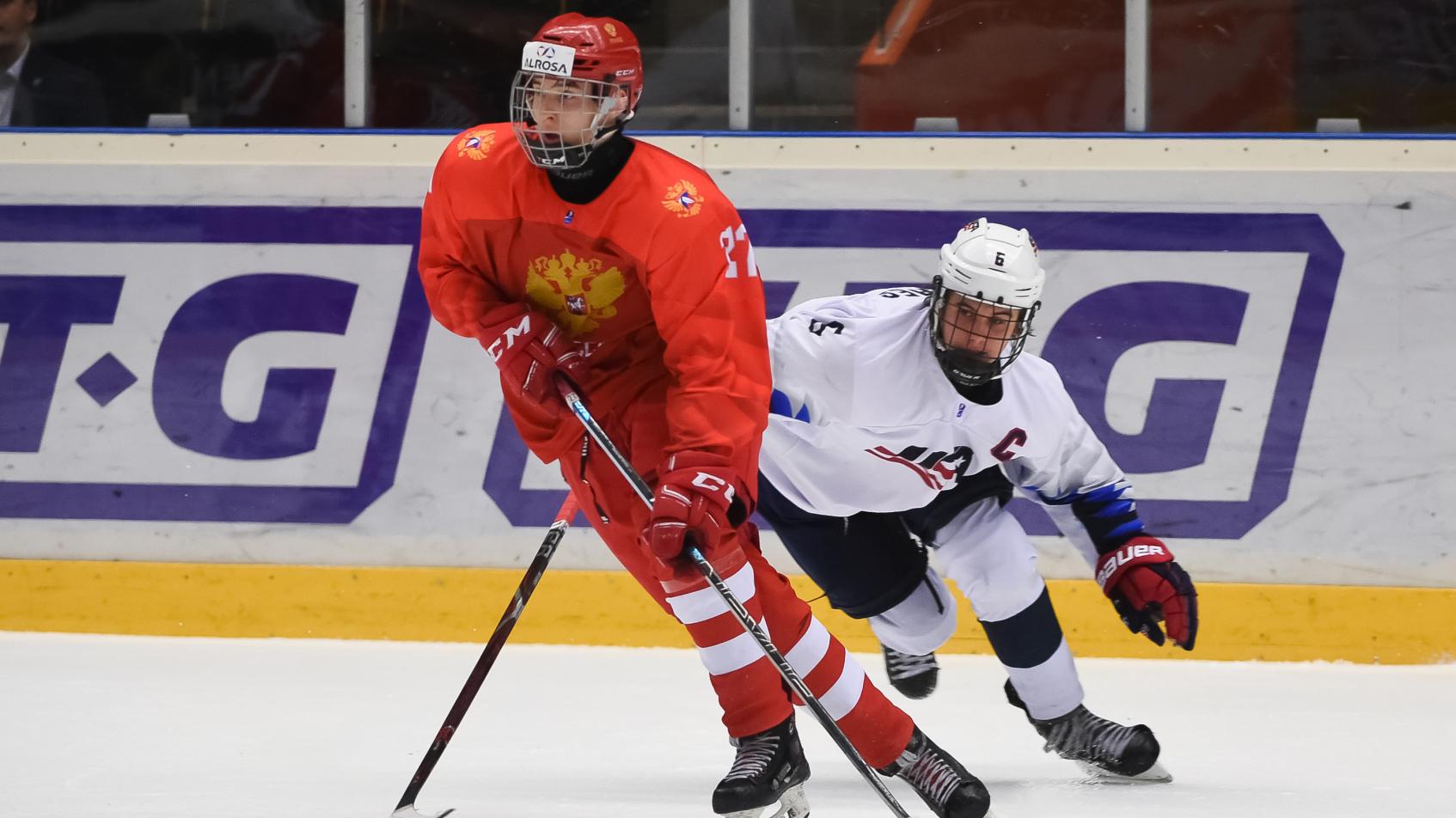With the 15th overall selection in the 2020 NHL Draft, the Toronto Maple Leafs have selected Russian left-shot winger Rodion Amirov of Salavat Yulaev Ufa (KHL).
The predraft rankings for the 6’0, 182-pound Amirov:
- Ranked 13th by MLHS’ Kevin Papetti
- Ranked 19th by TSN’s Bob McKenzie
- Ranked 19th by Sportsnet’s Sam Cosentino
- Ranked 25th by McKeen’s Hockey
- Ranked 23rd by HockeyProspect.com
- Ranked 16th by ISS
- Ranked 5th among European skaters by NHL Central Scouting
- Ranked 21st by TSN’s Crag Button
- Ranked 17th by EliteProspects.com
- Ranked 14th by Future Considerations
With an October 2, 2001 birthdate, Amirov is one of the older players in the 2020 draft class and already carries a fairly significant track record. After leading Russia in scoring in last year’s U18 tournament while playing on a line with Vasili Podkolzin, we can expect him to be one of his team’s top scorers at this year’s World Juniors (assuming the tournament takes place). The Salavat native also has 31 KHL games under his belt — including three goals and five points in 10 games to start this season — in addition to experience at the Hlinka-Gretzky tournament and World Junior A Challenge.
Amirov is a well-rounded player who can help his team in a variety of different ways. While he needs to add strength like most 18 year olds, he’s fairly tall, carries the puck well, goes to the high-danger areas, moves the puck effectively, and offers a fair amount of shooting talent. A good forechecker who can generate takeaways, he’s also an above-average skater. He always seems to be one of the better players on the ice (the Amirov-Podkolzin duo has been a force to be reckoned with when paired together).
Amirov’s size and speed combination makes him a relatively safe pick, but his transition skill and scoring ability also give him top-six upside. He dominated in the MHL on a line with Alexander Pashin this past year. MLHS’ Kevin Papetti surmised he may only be a year away from being NHL ready and labeled him a safe bet to be a top-six winger. He’s a standout in transition and offers two-way potential with his speed.
Leafs draft pick Rodion Amirov is signed with Salavat Yulaev Ufa through the end of this season. He's eligible to come to North America as soon as 2021-22 — although that's a decision not likely to be made until well down the road here.
— Chris Johnston (@reporterchris) October 7, 2020
The imperative of keeping the organizational pipeline flowing with high-end young talent within a Leafs system that has graduated — and lucratively paid — much of its former first-round talent motivated the club to keep this pick in a very deep 2020 draft and add more high-end skill to the prospect pool. They no doubt leaned heavily on Director of Player Evaluation Jim Paliafito and his network in Russia in moving ahead with this Amirov pick at 15th overall.
It’s unsurprising to anyone who is familiar with Kyle Dubas’ draft philosophy that he would’ve leaned on skill, speed, and hockey sense first here in projecting 18-year-old hockey players and did not factor in the present needs of the NHL roster in terms of either position (i.e. a winger, not a center or D) or player type (i.e. not a big, bruising, shutdown right-shot defenseman like Braden Schneider). It should be kept in mind that NHL scouts often mention Amirov’s compete level and nose for scoring inside the dots as well as his relatively rounded two-way game.
Welcome to the Leafs, Rodion.
Director of Amateur Scouting John Lilley on Rodion Amirov
He is doing well in the KHL right now with three goals and five points in 10 games in a low-scoring league. We have tracked him since his underage year. I believe he was the leading goal scorer in the U18 World Championships as an underage with Jack Hughes in that class. That is kind of where we really noticed him, at least our North American scouts, and we watched him for a couple of years.
He plays the right way. He is in on the forecheck. He tracks back hard. He has offensive talent and is a very good skater. He was someone we coveted for a few years now.
GM Kyle Dubas on the selection of Rodion Amirov
On the decision to hold onto the pick and select at 15th overall:
We had lots of conversations on moving the puck, but in the end, we were really comfortable — if we didn’t find a deal that we wanted — to select Rodion. Our staff really, really likes him a lot. I’ve gotten to know him a little bit here over this process and we have certainly done a lot of work on him. He’s off to a great start with Ufa in the KHL and I have spoken with their coaching staff and the national team staff. We are really excited about him.
On addressing grit in free agency and trade, not the draft:
It is a lot easier thing to address in those methods [free agency and trade]. Drafting an 18-year-old kid right now, especially in the middle of the first round, and expecting that they’re going to come in and address some of the needs that are mostly done by more mature, older players in the league wouldn’t be the most smart way to go about things. With this pick, we wanted a player that could help us out best in the long run and roll from there.
Dubas in depth on Amirov:
Dubas on Amirov: “We consider his speed among the best in the class & like his game on both sides of the puck… When you talk about drafting Russian forwards, the narrative is that they might not be a good two-way player, but this guy really is.”
— Maple Leafs Hotstove (@LeafsNews) October 7, 2020
Rodion Amirov Scouting Report
courtesy of the 2020 Blackbook (buy now)
Rodion Amirov has had a variety of experience over the course of the truncated 2019-20 season. He got into more than 20 games at the KHL level and finished the regular season and playoffs with his junior club for another 20+ game stint there. In the meantime, he also participated in the VHL playoffs in domestic play. More than that, he played in the Canada/Russia Junior Super Series and the Spengler Cup. While ice time was a little tough to come by for him in the KHL – averaging just a shade under 10 minutes per game – he was relied upon heavily on a star-studded junior club that finished first in its conference. With just two assists and a minus-6 rating in 21 KHL games, the statistics paint an unfair picture of Amirov’s skill set. At the junior level, he was good for 10 goals and 22 points in 17 regular-season games.
Amirov is a skilled, two-way winger who plays a finesse style of game. What really jumps out is how shifty and slick he is. Rodion is very difficult to pin down or gain a read on. This is in large part due to the combination of skating deception and craftiness he’s displayed. There’s a slipperiness to his style of play that allows him to take advantage of the game both in tight areas around the goal line and boards as well as in open space. The first factor that gives him his elusiveness and unpredictability is his skating.
Rodion is a mechanically sound skater who compensates for a lack of power by having excellent edge-work. He can pivot and turn rapidly, and he has a flexible set of hips that he lowers to suddenly change direction when needed. More importantly, he can contort his frame or use his edges to evade incoming checks, while still maintaining balance. He looks to consistently control the play along the boards by using his skating in combination with his hands, which are another highlighted attribute of his.
There are few players in this class who are as dangerous as Amirov in one-on-one situations, or when an opponent looks to be overly aggressive when attempting to cut off his lanes. This is due to having a dynamic set of hands. They’re lightning quick and also highly adaptable. He rarely uses pre-set moves, relying heavily on his ability to improvise and react to what’s given to him by the defense. He demonstrated a terrific ability to catch long, hard passes cleanly and also can kick pucks back from his skate to his blade effortlessly, giving him a high degree of control when he’s in traffic.
His hands are the most prominent aspect of his skill, but he’s also someone we would label as a dual-threat. His playmaking falls behind some of the highest-end playmakers in this class, but he’s more than capable of making difficult and technical saucer passes. Furthermore, he can cycle the puck well along the boards, and there’s a consistency to both his precision and velocity that he threads passes with.
Amirov’s shot is ahead of his playmaking ability. There’s an excellent level of coordination features within aspects of his release. He’s not mechanically perfect with his footwork or gaining inside positioning on his shot using his footwork, but he does feature the ability to rapidly rotate through his release using his hips, core, and shoulders. His follow-through is consistent and he has a good eye for identifying seams on goalies, specifically when looking to shoot far-side when he’s cutting against the grain. His shot can be transitioned from his hands while in motion, and this gives him both a deceptive and quick release point as well.
As mentioned earlier, the hallmarks of this player are based on his elusiveness and shiftiness, which are generated not just through his technical elements but through his mental ones as well. He’s a creative and deceptive player. We’ve seen him attempt a lacrosse-style pass from below the goal line, let alone a lacrosse style shot. One of the aspects of creativity we look for: If a player can make something happen out of a nothing looking play. Amirov has that ability.
The most impressive aspect of his deception is his skating deception. He’s very good at drawing opponents into one area of the ice so that he can re-adjust his lanes and reconfigure his options by exaggerating his posture so that he looks like he’s going to start up in one direction before heading in another. This is specifically for his skating fakes, though, and not his head fakes. His head fakes are more prominent when he looks to execute his playmaking on the power play. He’s been inconsistent in our viewings at looking off his intended targets at even strength. This happened most prominently during odd-man rushes.
Although there is some inconsistency with his head fakes, the most consistent aspect of this player is his spatial awareness away from the puck. He’s very good at recognizing soft ice that can put him in high-danger scoring areas and he has no issue getting to the more difficult areas of the ice. His craftiness expands to being able to drift into backdoor passing areas, and he’s good at anticipating rebounds so that he can time his shot off an initial save from an opposing goalie.
His anticipation off the puck extends to the defensive side. We’ve seen him close off lanes and intercept passes using his anticipation and stick several times. His anticipation with the puck is good as well. There’s recognition regardless if the pace went up, which bodes well for Amirov. Against men, he seemed to still be comfortable at matching his decision making to the pace of play. That said, there were instances where he would misidentify his time and space, too — specifically, when looking to set up his release in traffic. Another aspect of his hockey sense that we would label as a work in progress was his tempo control.
Some prospects play with a high-octane motor too much and need to learn to slow the play down, but Amirov is the opposite. We look for a balance between speeding the play up when the plays calls for it and slowing it down when the play calls for it. Rodion looks to slow down the play when he gets over the offensive line too often and not always at the right times. What’s frustrating is how successful he has been when he has decided to speed the play back up as well. Some of our best viewings of him were when he was featured at the Spengler Cup and against Humo Tashkent in the VHL playoffs. In some of those viewings, he was more than willing to drive the puck north-south while increasing his gear, but in the MHL and the Super-Series, you were much more likely to see him slow the play back down.
In the junior league playoffs, he was held scoreless with a minus-4 rating through the first four games of the series against a #8 seed before coming through with two points in the deciding game. And it’s not that he was invisible throughout the series — he has the talent to be good enough even at 60% speed, and he showed it off – but we’d love him more if he revved it up more often. There’s also a lack of balance between attacking east-west and north-south that he needs to have in order to translate.
Although there are some attributes that he needs to continue to develop on the mental side of the puck, that doesn’t mean he can’t translate his game. One sequence in a game against HC Ambri represents these translatable qualities. Late in the third period, Amirov received a pass along the right half-wall in the offensive zone. He took the pass, then slipped off of an attempted check by spinning away from it. This gave him the room to skate down below the goal-line with the puck. The Ambri player who just attempted to put him through the boards skated aggressively towards him to cut off his potential skating lane. Unfortunately for the Ambri player, Amirov had drawn him into the wrong skating direction using both a head and body fake. With Rodion’s opponent now over skating the play, he flicked out his stick. Amirov sidestepped the outstretched arm, then kicked the puck back to his stick and threaded a tape to tape pass through multiple bodies to his teammate, who missed an open net.
Amirov’s strength is lacking and is an area that needs improvement. There’s an inconsistency in the amount of power featured through his upper and lower half. His shot is affected as a result of him relying on his rotation. He’s a mechanically gifted shooter as mentioned, but when the mechanics break down, depending on his fatigue or if he mistimes his release, the power isn’t there to compensate as of this writing. This extends into his north-south skating. Amirov is more comfortable slowing the play down and attacking east-west as mentioned earlier. Part of this might be attributable to lacking the power to separate from pro players when skating in a straight line. His preference for east-west attacking can take him too wide, allowing defenders to establish the dot line on him, marginalizing his room to make plays. This was one of the reasons he had less success in the KHL in 2019-20.
Amirov can come off as more calculated then urgent, which can give off the wrong impression of him. He’s a 200-foot player who doesn’t play scared and can make successful backchecks. That said, he lets the game come to him too often when he’s not engaged. An engaged Amirov is a dual offensive zone threat that is tough to contain and can make highlight-reel plays, where he goes through multiple layers of defense against top-quality pro players. We’ve seen games where he gets a lot of pucks back in the low neutral zone or in his own end. Even at the KHL level, he can work well on the cycle and maintain puck possession – the ability to be effective is certainly there regardless of his young age in a top league. On the other side, his conditioning and gear shifting can be lacking when he needs it most.
Rodion Amirov was one of the more interesting evaluations for us in this draft class. He’s very talented and naturally gifted in areas of the game that you can’t teach a player to get better in. When predicting how he can translate on North American ice, a lot may depend on how much stronger and faster he can become. He needs strength regardless of how elusive he already is; in the NHL, he will get pinned and he will need to be able to fight through checks and absorb contact. He must also develop further power in his lower half so that he can be more threatening north-south and in transitional play. If he can become more consistent in terms of his engagement levels and continue to physically develop, he has a real chance of becoming a second-line winger who you can also slot on a power play.
Despite his ceiling, we view Amirov as a prospect most likely to be used as a versatile winger who can complement a skill line in a middle-six role. His ceiling fits into a top-six role, but the floor isn’t high. When factoring his floor, it drops him down our tier range where we have some other prospects who have a similar level of skill but who we consider to have higher floors.
Rodion Amirov Video
Rodion Amirov Statistics
| S | Team | League | GP | G | A | TP | PIM | +/- |
|---|---|---|---|---|---|---|---|---|
| 2016-17 | Salavat Yulaev Ufa U16 | Russia U16 | 30 | 18 | 18 | 36 | 20 | |
| 2017-18 | Salavat Yulaev Ufa U17 | Russia U17 | 30 | 24 | 29 | 53 | 20 | 52 |
| Tolpar Ufa | MHL | 12 | 2 | 1 | 3 | 4 | 0 | |
| Russia U17 (all) | International-Jr | 4 | 2 | 1 | 3 | 4 | ||
| 2018-19 | Salavat Yulaev Ufa U18 | Russia U18 | 9 | 9 | 13 | 22 | 2 | 21 |
| Tolpar Ufa | MHL | 31 | 13 | 13 | 26 | 14 | 20 | |
| Russia U18 | WJC-18 | 7 | 6 | 3 | 9 | 2 | 4 | |
| Russia U18 (all) | International-Jr | 27 | 13 | 9 | 22 | 12 | ||
| 2019-20 | Salavat Yulaev Ufa | KHL | 21 | 0 | 2 | 2 | 4 | -6 |
| Toros Neftekamsk | VHL | 5 | 1 | 2 | 3 | 0 | 0 | |
| Tolpar Ufa | MHL | 17 | 10 | 12 | 22 | 31 | 13 | |
| Russia U20 (all) | International-Jr | 7 | 1 | 2 | 3 | 2 | ||
| Russia II (all) | International | 1 | 0 | 0 | 0 | 0 | 0 | |
| 2020-21 | Salavat Yulaev Ufa | KHL | 10 | 3 | 2 | 5 | 4 | -1 |
| Toros Neftekamsk | VHL | 3 | 1 | 1 | 2 | 0 | 0 |


































